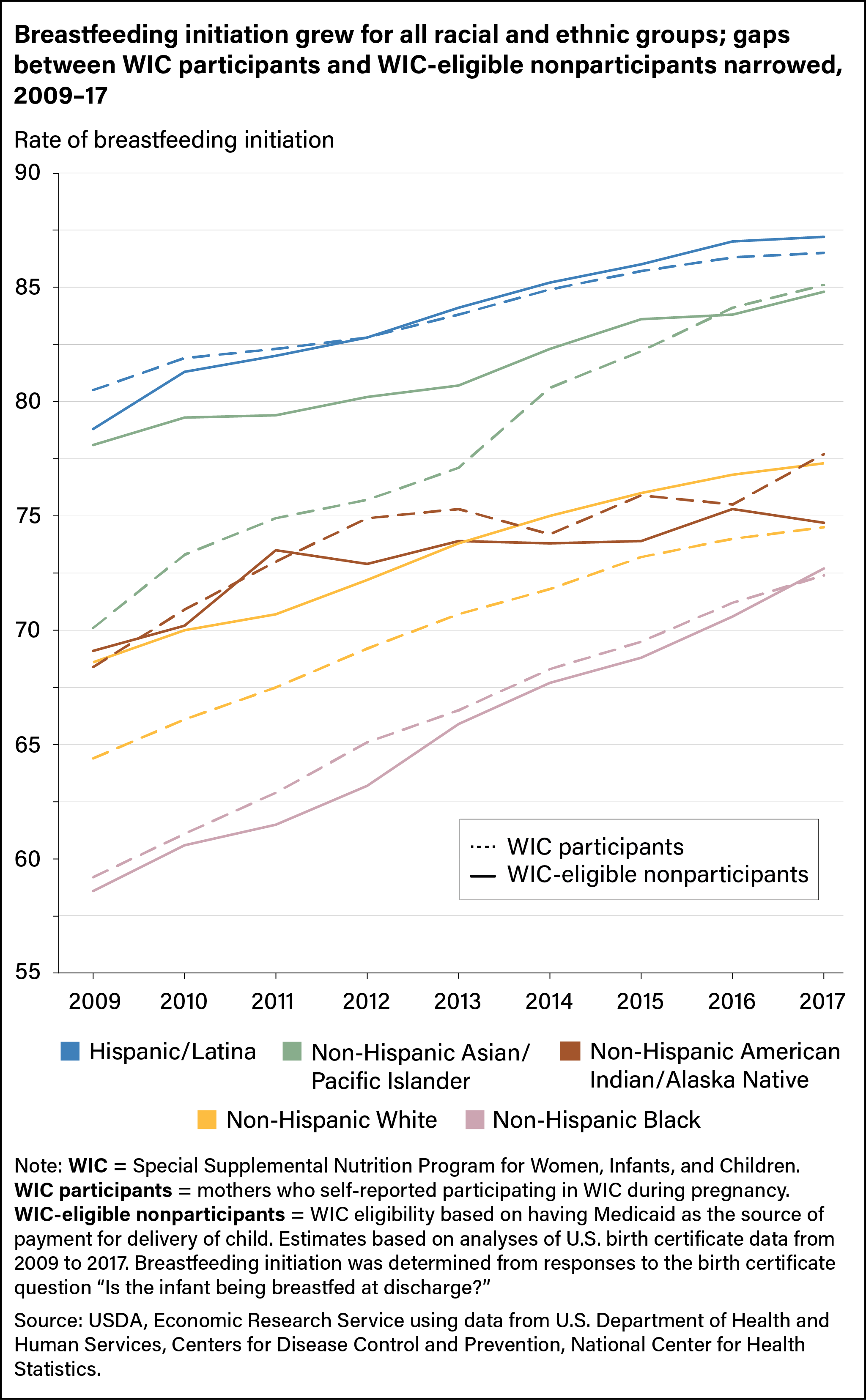
Rates of Breastfeeding Initiation Increased Among Low-Income Women, 2009–17; Racial and Ethnic Disparities Persist
- by Leslie Hodges, Joanne Guthrie, Anna Shetler and Marie Thoma
- 10/23/2023
Breastfeeding offers health benefits to women and their children and is therefore promoted by USDA’s Special Supplemental Nutrition Program for Women, Infants, and Children (WIC). Researchers at USDA, Economic Research Service and the University of Maryland described recent trends in breastfeeding initiation among low-income women by WIC participation status and by race and ethnicity. They studied trends since 2009, when revisions were made to WIC food packages that were intended to promote breastfeeding, among a suite of updates to improve the overall health of WIC participants.
Breastfeeding initiation was determined from responses to a birth certificate question asking whether the infant was breastfeeding at the time of discharge from the hospital. Using that birth certificate data available from 24 States, the researchers found that breastfeeding initiation increased for low-income women in all racial and ethnic groups from 2009 to 2017. Moreover, gaps in rates of breastfeeding initiation between WIC participants and eligible nonparticipants within some racial and ethnic groups narrowed.
Breastfeeding is considered the best source of nutrition for infants in the United States and benefits the health of postpartum women. Promotion of breastfeeding has been an aim of each iteration of the Healthy People initiative, the Federal Government’s blueprint to build a healthier future for all. Healthy People 2020, the fourth iteration of the initiative, was launched in December 2010 and, among many objectives related to maternal and child health, aimed to increase the proportion of infants ever breastfed from 76.1 percent (the rate in 2009) to 81.9 percent. Despite reaching this overall milestone by 2014, breastfeeding rates fell short of the 81.9 percent mark for infants in some racial and ethnic groups, for infants living in lower income households, and for infants participating in USDA’s WIC program.
WIC provides supplemental foods, nutrition education, and healthcare referrals to safeguard the health of pregnant and postpartum women, infants, and children up to age 5 and is the cornerstone of USDA’s efforts to promote breastfeeding. Federal regulations require that State WIC agencies use a portion of the Federal funding they receive to administer WIC for breastfeeding support. State WIC agencies must also create policies and procedures to ensure breastfeeding support is provided throughout the prenatal and postpartum period. All WIC staff members are trained to encourage breastfeeding and provide the support mothers and infants need for success. However, WIC also offers infant formula as an option to infants who are not fully breastfed, and there have been lower rates of breastfeeding initiation among WIC participants compared with eligible nonparticipants. By 2009, WIC State agencies had implemented revisions to WIC packages that provided more food to breastfeeding mothers in order to increase nutritional support for breastfeeding individuals and possibly provide a greater economic incentive to breastfeed.
The researchers examined trends in breastfeeding initiation by WIC participation status for five racial and ethnic groupings: non-Hispanic White, non-Hispanic Black, non-Hispanic American Indian/Alaska Native, non-Hispanic Asian/Pacific Islander, and Hispanic/Latina of any race. These groupings are not without limitations. Aggregating in this way, particularly combining Asian with Pacific Islander, precludes the ability to understand trends and patterns for distinct populations within these groups.
From 2009 to 2017, rates of breastfeeding initiation increased among low-income women regardless of WIC participation status or race/ethnicity. Hispanic women (both WIC participants and WIC-eligible nonparticipants) had the highest rates of breastfeeding initiation throughout the study period. Non-Hispanic Black women had the lowest rates of breastfeeding initiation, but they experienced the largest gains, with increases of 22.3 percent among WIC participants and 24.1 percent among WIC-eligible nonparticipants. In other words, non-Hispanic Black women’s rates of breastfeeding initiation increased the most of any racial/ethnic group from 2009 to 2017, reducing the disparity in rates of breastfeeding initiation between non-Hispanic Black women (both WIC participants and WIC-eligible nonparticipants) and women in other racial and ethnic groups.
Compared with WIC-eligible nonparticipants, WIC participants continued to have lower rates of breastfeeding initiation overall, although the gap in initiation between WIC-eligible nonparticipants and WIC participants closed for some racial/ethnic groups. In 2009, Asian/Pacific Islander women had the largest gap in breastfeeding initiation by WIC status. By 2017, this gap had narrowed and reversed direction because of a greater increase in breastfeeding initiation among WIC participants (21.4 percent) compared with WIC-eligible nonparticipants (8.6 percent). This pattern was also observed for American Indian/Alaska Native women, for whom breastfeeding initiation rates increased by 13.6 percent among WIC participants compared with 8.1 percent among WIC-eligible nonparticipants, and for non-Hispanic White women, for whom breastfeeding initiation increased by 15.7 percent among WIC participants compared with 12.7 percent among WIC-eligible nonparticipants.
This article is drawn from:
- Thoma, M.E., De Silva, D.A., Kim, J., Hodges, L. & Guthrie, J. (2023). Breastfeeding initiation trends by Special Supplemental Nutrition Program for Women, Infants, and Children participation and race/ethnicity among Medicaid births. Journal of Nutrition Education and Behavior. https://doi.org/10.1016/j.jneb.2022.09.006.
You may also like:
- Tiehen, L. (2010, December 1). WIC Infants Less Likely To Be Exclusively Breastfed. Amber Waves, U.S. Department of Agriculture, Economic Research Service.
- WIC Program. (n.d.). U.S. Department of Agriculture, Economic Research Service.
- Oliveira, V., Prell, M. & Cheng, X. (2019, February 14). Economic Implications of Increased Breastfeeding Rates in WIC. Amber Waves, U.S. Department of Agriculture, Economic Research Service.
- Oliveira, V., Prell, M. & Cheng, X. (2019). The Economic Impacts of Breastfeeding: A Focus on USDA’s Special Supplemental Nutrition Program for Women, Infants, and Children (WIC). U.S. Department of Agriculture, Economic Research Service. ERR-261.
- Oliveira, V. & Frazão, E. (2015). The WIC Program: Background, Trends, and Economic Issues, 2015 Edition. U.S. Department of Agriculture, Economic Research Service. EIB-134.


